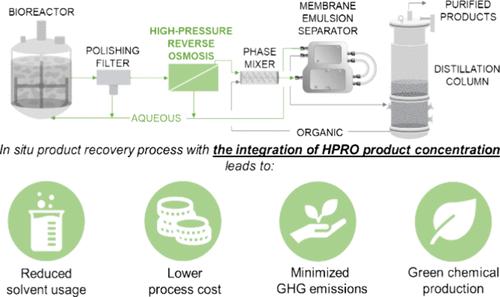高压反渗透在下游生物加工中的羧酸浓度研究
IF 7.3
1区 化学
Q1 CHEMISTRY, MULTIDISCIPLINARY
引用次数: 0
摘要
在通过发酵和酶促过程生产许多生物基化学品的过程中,产品分离通常是综合过程中最昂贵和能源密集型的单元操作,通常是由于目标生物产品的低浓度。在这项研究中,我们整合了高压反渗透(HPRO)浓缩发酵产物,丁酸,在下游提取之前。通过建模和实验测量,我们确定了限制HPRO膜的丁酸浓度的最大可实现浓度因子(CF)为4.0的主要因素,而传统反渗透(RO)膜的最大可实现浓度因子(CF)为2.6-3.2。得到的浓缩水流经有机溶剂液液萃取,蒸馏后进行丁酸提纯和溶剂回收。将HPRO产品浓度整合到原位产品回收(ISPR)过程中,有机相的最终丁酸浓度增加了5倍,同时有机溶剂的使用量减少了76%。这些改进导致ISPR丁酸生产成本和温室气体(GHG)排放分别降低了53%和46%,大大超过了整合传统RO产品浓度时的工艺性能。总的来说,集成HPRO膜的产品浓度可以从稀水流中更经济和可持续地回收生物产品。本文章由计算机程序翻译,如有差异,请以英文原文为准。

Carboxylic Acid Concentration in Downstream Bioprocessing Using High-Pressure Reverse Osmosis
During the production of many bio-based chemicals from fermentation and enzymatic processes, product separations frequently represent the most expensive and energy-intensive unit operations in an integrated process, often due to the low concentrations of target bioproducts. In this study, we integrated high-pressure reverse osmosis (HPRO) to concentrate an exemplary fermentation product, butyric acid, prior to downstream extraction. Through both modeling and experimental measurements, we identified the major factors limiting the maximum achievable concentration factor (CF) of 4.0 for butyric acid concentration with an HPRO membrane compared to the 2.6–3.2 range for conventional reverse osmosis (RO) membranes. The resulting concentrated aqueous stream underwent liquid–liquid extraction with an organic solvent and distillation for butyric acid purification and solvent recycling. The integration of HPRO product concentration into an in situ product recovery (ISPR) process leads to >5-fold increase in the final butyric acid concentration in the organic phase, and a concomitant 76% reduction in organic solvent usage. These improvements lead to an estimated 53 and 46% reduction in ISPR butyric acid production cost and greenhouse gas (GHG) emissions, respectively, considerably exceeding the process performance when integrating conventional RO product concentration. Overall, the integration of an HPRO membrane for product concentration enables more economical and sustainable bioproduct recovery from dilute aqueous streams.
求助全文
通过发布文献求助,成功后即可免费获取论文全文。
去求助
来源期刊

ACS Sustainable Chemistry & Engineering
CHEMISTRY, MULTIDISCIPLINARY-ENGINEERING, CHEMICAL
CiteScore
13.80
自引率
4.80%
发文量
1470
审稿时长
1.7 months
期刊介绍:
ACS Sustainable Chemistry & Engineering is a prestigious weekly peer-reviewed scientific journal published by the American Chemical Society. Dedicated to advancing the principles of green chemistry and green engineering, it covers a wide array of research topics including green chemistry, green engineering, biomass, alternative energy, and life cycle assessment.
The journal welcomes submissions in various formats, including Letters, Articles, Features, and Perspectives (Reviews), that address the challenges of sustainability in the chemical enterprise and contribute to the advancement of sustainable practices. Join us in shaping the future of sustainable chemistry and engineering.
 求助内容:
求助内容: 应助结果提醒方式:
应助结果提醒方式:


